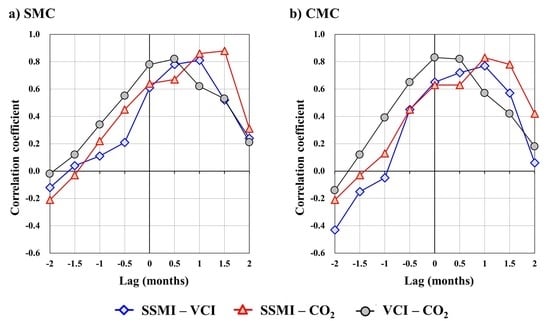Soil Moisture–Vegetation–Carbon Flux Relationship under Agricultural Drought Condition using Optical Multispectral Sensor
Abstract
1. Introduction
2. Materials and Methods
2.1. Study Area
2.2. Optical Multispectral Sensor Dataset
2.3. Calculation of CO2 Flux
2.4. Measurement of Soil Moisture Content by Optical Multispectral Sensor
2.5. Agricultural Drought Indices
2.5.1. Vegetation Condition Index (VCI)
2.5.2. Standardized Soil Moisture Index (SSMI)
3. Results and Discussion
3.1. Comparative Analysis of Optical Sensor Products and In Situ Data
3.1.1. Temporal Variations of Soil Moisture and Comparison with Ground Observation
3.1.2. Temporal Variations of CO2 Flux and Comparison with Ground Observation
3.2. Analysis of Relationship SM-VI-CO2 under Drought Condition
3.2.1. Selecting Drought Periods Using Agricultural Drought Indices
3.2.2. Drought Analysis and Validation during Drought Period
3.2.3. Relationship between SM, Vegetation and CO2 during Drought Periods
4. Conclusions
Author Contributions
Funding
Acknowledgments
Conflicts of Interest
References
- Heim, J.R.R. A review of twentieth-century drought indices used in the United States. Bull. Am. Meteorol. Soc. 2002, 83, 1149–1165. [Google Scholar] [CrossRef]
- Mishra, A.K.; Desai, V.R. Drought forecasting using stochastic models. Stoch. Environ. Res. Risk Assess. 2005, 19, 326–339. [Google Scholar] [CrossRef]
- Wilhite, D.A.; Svoboda, M.D.; Hayes, M.J. Understanding the complex impacts of drought: A key to enhancing drought mitigation and preparedness. Water Resour. Manag. 2007, 21, 763–774. [Google Scholar] [CrossRef]
- Wu, Z.; Mao, Y.; Li, X.; Lu, G.; Lin, Q.; Xu, H. Exploring spatiotemporal relationships among meteorological, agricultural, and hydrological droughts in Southwest China. Stoch. Environ. Res. Risk Assess. 2016, 30, 1033–1044. [Google Scholar] [CrossRef]
- Kim, J.S.; Seo, G.S.; Jang, H.W.; Lee, J.H. Correlation analysis between Korean spring drought and large-scale teleconnection patterns for drought forecast. KSCE J. Civ. Eng. 2017, 21, 458–466. [Google Scholar] [CrossRef]
- Sivakumar, M.V.K.; Motha, R.P.; Wilhite, D.A.; Qu, J.J. Towards a compendium on national drought policy. In Proceedings of the an Expert Meeting on the Preparation of a Compendium on National Drought Policy, World Meteorological Organization, Washington, DC, USA, 14–15 July 2011; pp. 1–135. [Google Scholar]
- Sur, C.; Park, S.-Y.; Kim, T.-W.; Lee, J.-H. Remote sensing-based agricultural drought monitoring using hydrometeorological variables. KSCE J. Civ. Eng. 2019, 23, 5244–5256. [Google Scholar] [CrossRef]
- Kogan, F.N. Global drought watch from space. Bull. Am. Meteorol. Soc. 1997, 78, 621–636. [Google Scholar] [CrossRef]
- Vicente-Serrano, S.M.; Begueria, S.; Lopez-Moreno, J.I. A multiscalar drought index sensitive to global warming: The standardized precipitation evapotranspiration index. J. Clim. 2010, 23, 1696–1718. [Google Scholar] [CrossRef]
- Zhang, A.; Jia, G. Monitoring meteorological drought in semiarid regions using multi-sensor microwave remote sensing data. Remote Sens. Environ. 2013, 134, 12–23. [Google Scholar] [CrossRef]
- Keshavarz, M.R.; Vazifedoust, M.; Alizadeh, A. Drought monitoring using a soil wetness deficit index (SWDI) derived from MODIS satellite data. Agric. Water Manag. 2014, 132, 37–45. [Google Scholar] [CrossRef]
- Moorhead, J.E.; Gowda, P.H.; Singh, V.P.; Porter, D.O.; Marek, T.H.; Howell, T.A.; Stewart, B.A. Identifying and evaluating a suitable index for agricultural drought monitoring in the Texas High Plains. J. Am. Water Resour. Assoc. 2015, 51, 807–820. [Google Scholar] [CrossRef]
- Liu, X.; Zhu, X.; Pan, Y.; Li, S.; Liu, Y.; Ma, Y. Agricultural drought monitoring: Progress, challenges, and prospects. J. Geogr. Sci. 2016, 26, 750–767. [Google Scholar] [CrossRef]
- Sánchez, N.; González-Zamora, A.; Martínez-Fernández, J.; Piles, M.; Pablos, M. Integrated remote sensing approach to global agricultural drought monitoring. Agric. For. Meteorol. 2018, 259, 141–153. [Google Scholar] [CrossRef]
- Peters, A.J.; Walter-Shea, E.A.; Ji, L.; Vliia, A.; Hayes, M.; Svoboda, M.D. Drought monitoring with NDVI-based standardized vegetation–index. Photogramm. Eng. Rem. Sens. 2002, 68, 71–75. [Google Scholar]
- Bajgain, R.; Xiao, X.; Wagle, P.; Basara, J.; Zhou, Y. Sensitivity analysis of vegetation indices to drought over two tallgrass prairie sites. ISPRS J. Photogramm. 2015, 108, 151–160. [Google Scholar] [CrossRef]
- Dong, C.; MacDonald, G.M.; Willis, K.; Gillespie, T.W.; Okin, G.S.; Williams, A.P. Vegetation responses to 2012–2016 drought in Northern and Southern California. Geophys. Res. Lett. 2019, 46, 3810–3821. [Google Scholar] [CrossRef]
- Hu, X.; Ren, H.; Tansey, K.; Zheng, Y.; Ghent, D.; Liu, X.; Yan, L. Agricultural drought monitoring using European Space Agency Sentinel 3A land surface temperature and normalized difference vegetation index imageries. Agric. For. Meteorol. 2019, 279, 107707. [Google Scholar] [CrossRef]
- Njoku, E.G.; Jackson, T.J.; Lakshmi, V.; Chan, T.K.; Nghiem, S.V. Soil moisture retrieval from AMSR-E. IEEE Trans. Geosci. Remote 2003, 41, 215–229. [Google Scholar] [CrossRef]
- Cho, E.; Choi, M.; Wagner, W. An assessment of remotely sensed surface and root zone soil moisture through active and passive sensors in northeast Asia. Remote Sens. Environ. 2015, 160, 166–179. [Google Scholar] [CrossRef]
- Anam, R.; Chishtie, F.; Ghuffar, S.; Qazi, W.; Shahid, I. Inter-comparison of SMOS and AMSR-E soil moisture products during flood years (2010–2011) over Pakistan. Eur. J. Remote Sens. 2017, 50, 442–451. [Google Scholar] [CrossRef]
- Portal, G.; Jagdhuber, T.; Vall-llossera, M.; Camps, A.; Pablos, M.; Entekhabi, D.; Piles, M. Assessment of Multi-Scale SMOS and SMAP Soil Moisture Products across the Iberian Peninsula. Remote Sens. 2020, 12, 570. [Google Scholar] [CrossRef]
- Deng, K.A.K.; Lamine, S.; Pavlides, A.; Petropoulos, G.P.; Bao, Y.; Srivastava, P.K.; Guan, Y. Large Scale Operational Soil Moisture Mapping from Passive MW Radiometry: SMOS product evaluation in Europe & USA. Int. J. Appl. Earth Obs. 2019, 80, 206–217. [Google Scholar] [CrossRef]
- Verstraeten, W.W.; Veroustraete, F.; van der Sande, C.J.; Grootaers, I.; Feyen, J. Soil moisture retrieval using thermal inertia, determined with visible and thermal spaceborne data, validated for European forests. Remote Sens. Environ. 2006, 101, 299–314. [Google Scholar] [CrossRef]
- Chang, T.-Y.; Wang, Y.-C.; Feng, C.-C.; Ziegler, A.D.; Giambelluca, T.W.; Liou, Y.-A. Estimation of root zone soil moisture using apparent thermal inertia with MODIS imagery over a tropical catchment in Northern Thailand. IEEE J. Sel. Top. Appl. 2012, 5, 752–761. [Google Scholar] [CrossRef]
- Van doninck, J.; Peters, J.; De Baets, B.; De Clercq, E.M.; Ducheyne, E.; Verhoest, N.E.C. The potential of multitemporal Aqua and Terra MODIS apparent thermal inertia as a soil moisture indicator. Int. J. Appl. Earth Obs. Geoinf. 2011, 13, 934–941. [Google Scholar] [CrossRef]
- Ghilain, N.; Arboleda, A.; Batelaan, O.; Ardö, J.; Trigo, I.; Barrios, J.-M.; Gellens-Meulenberghs, F. A New Retrieval Algorithm for Soil Moisture Index from Thermal Infrared Sensor On-Board Geostationary Satellites over Europe and Africa and Its Validation. Remote Sens. 2019, 11, 1968. [Google Scholar] [CrossRef]
- Running, S.W.; Nemani, R.R. Relating seasonal patterns of the AVHRR vegetation index to simulated photosynthesis and transpiration of forests in different climates. Remote Sens. Environ. 1988, 24, 347–367. [Google Scholar] [CrossRef]
- Gamon, J.A.; Field, C.B.; Goulden, M.L.; Griffin, K.L.; Hartley, A.E.; Joel, G.; Peñuelas, J.; Valentini, R. Relationships between NDVI, canopy structure, and photosynthesis in three californian vegetation types. Ecol. Appl. 1995, 5, 28–41. [Google Scholar] [CrossRef]
- Muraoka, H.; Noda, H.M.; Nagai, S.; Motohka, T.; Saitoh, T.M.; Nasahara, K.N.; Saigusa, N. Spectral vegetation indices as the indicator of canopy photosynthetic productivity in a deciduous broadleaf forest. J. Plant Ecol. 2013, 6, 393–407. [Google Scholar] [CrossRef]
- Sur, C.; Kang, S.; Kim, J.-S.; Choi, M. Remote sensing-based evapotranspiration algorithm: A case study of all sky conditions on a regional scale. GISci. Remote Sens. 2015, 52, 627–642. [Google Scholar] [CrossRef]
- NASA earthdata website. Available online: https://search.earthdata.nasa.gov/search (accessed on 10 October 2019).
- Kwon, H.; Park, S.; Kang, M.; Yoo, J.; Yuan, R.; Kim, J. Quality control and assurance of eddy covariance data at two KoFlux sites. Korean J. Agric. For. Meteorol. 2007, 9, 260–267. [Google Scholar] [CrossRef]
- Amthor, J.S.; Chen, J.M.; Clein, J.S.; Frolking, S.E.; Goulden, M.L.; Grant, R.F.; Kimball, J.S.; King, A.W.; McGuire, A.D.; Nikolov, N.T.; et al. Boreal forest CO2 exchange and evapotranspiration predicted by nine ecosystem process models: Intermodal comparisons and relationships to field measurements. J. Geophys. Res. Atmos. 2001, 106, 33623–33648. [Google Scholar] [CrossRef]
- Kramer, K.; Leinonen, I.; Bartelink, H.H.; Berbigier, P.; Borghetti, M.; Bernhofer, C.H.; Cienciala, E.; Dolman, A.J.; Froer, O.; Gracia, C.A.; et al. Evaluation of six process-based forest growth models using eddy-covariance measurements of CO2 and H2O fluxes at six forest sites in Europe. Glob. Chang. Biol. 2002, 8, 213–230. [Google Scholar] [CrossRef]
- Hanson, P.J.; Amthor, J.S.; Wullschleger, S.D.; Wilson, K.B.; Grant, R.F.; Hartley, A.; Hui, D.; Hunt, E.R.; Johnson, D.W.; Kimball, J.S.; et al. Oak forest carbon and water simulations: Model intercomparisons and evaluations against independent data. Ecol. Monogr. 2004, 74, 443–489. [Google Scholar] [CrossRef]
- Lloyd, J.; Taylor, J.A. On the temperature dependence of soil respiration. Funct. Ecol. 1994, 8, 315–323. [Google Scholar] [CrossRef]
- Sur, C.; Choi, M. Evaluating ecohydrological impacts of vegetation activities on climatological perspectives using MODIS gross primary productivity and evapotranspiration products at Korean regional flux network site. Remote Sens. 2013, 5, 2534–2553. [Google Scholar] [CrossRef]
- Kwon, H.-H.; Lall, U.; Kim, S.-J. The unusual 2013–2015 drought in South Korea in the context of a multicentury precipitation record: Inferences from a nonstationary, multivariate, Bayesian copula model. Geophys. Res. Lett. 2016, 43, 8534–8544. [Google Scholar] [CrossRef]
- Park, S.Y.; Sur, C.; Kim, J.S.; Lee, J.H. Evaluation of multi-sensor satellite data for monitoring different drought impacts. Stoch. Environ. Res. Risk Assess. 2018, 32, 2551–2563. [Google Scholar] [CrossRef]
- Lee, J.H.; Park, S.Y.; Kim, J.S.; Sur, C.; Chen, J. Extreme drought hotspot analysis for adaptation to a changing climate: Assessment of applicability to the five major river basins of the Korean Peninsula. Int. J. Climatol. 2018, 38, 4025–4032. [Google Scholar] [CrossRef]
- Choi, M.; Mu, Q.; Kim, H.; Hwang, K.; Hur, J. Ecosystem-dynamics link to hydrologic variations for different land-cover types. Terr. Atmos. Ocean. Sci. 2017, 28, 437–462. [Google Scholar] [CrossRef]

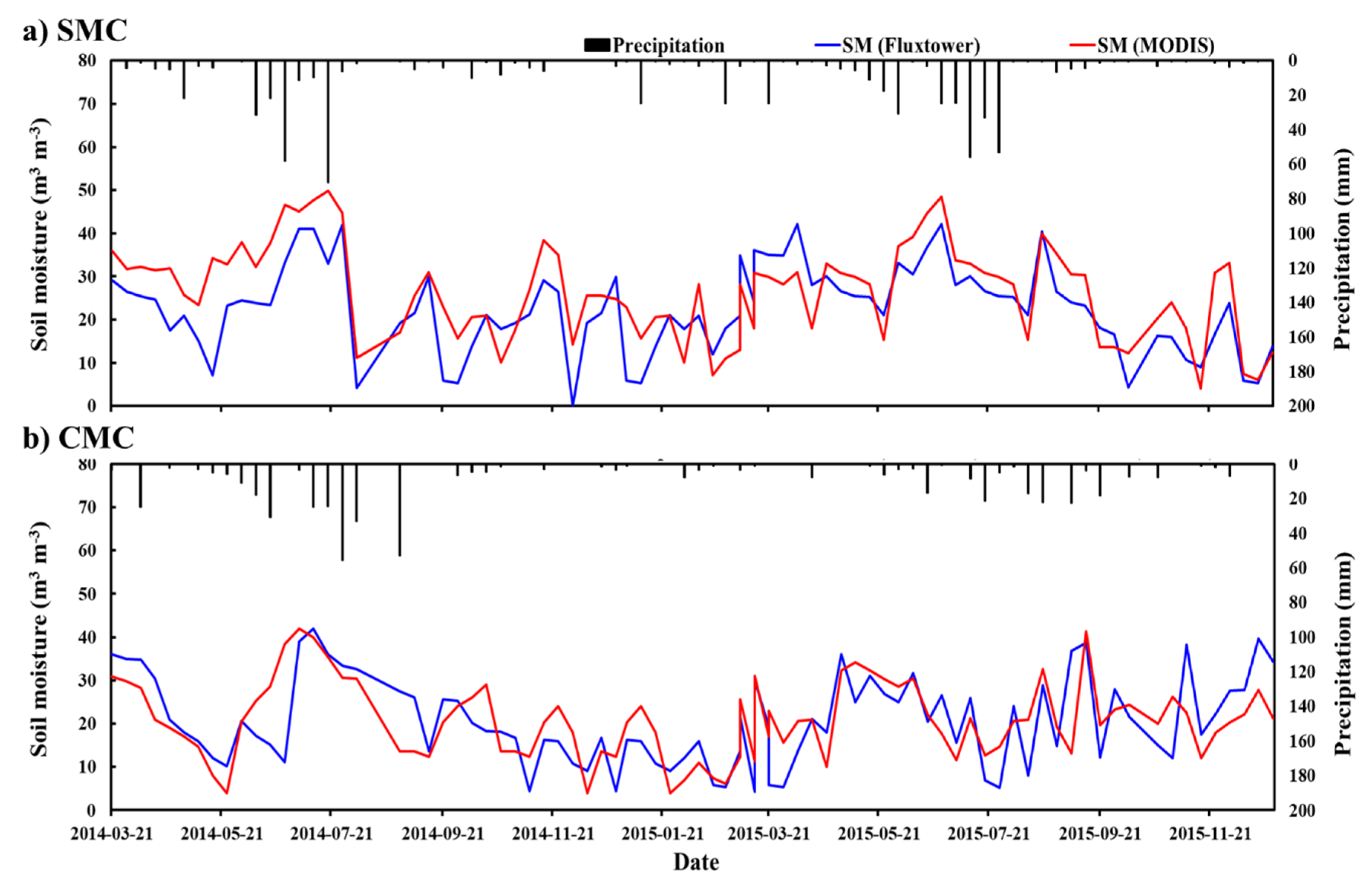

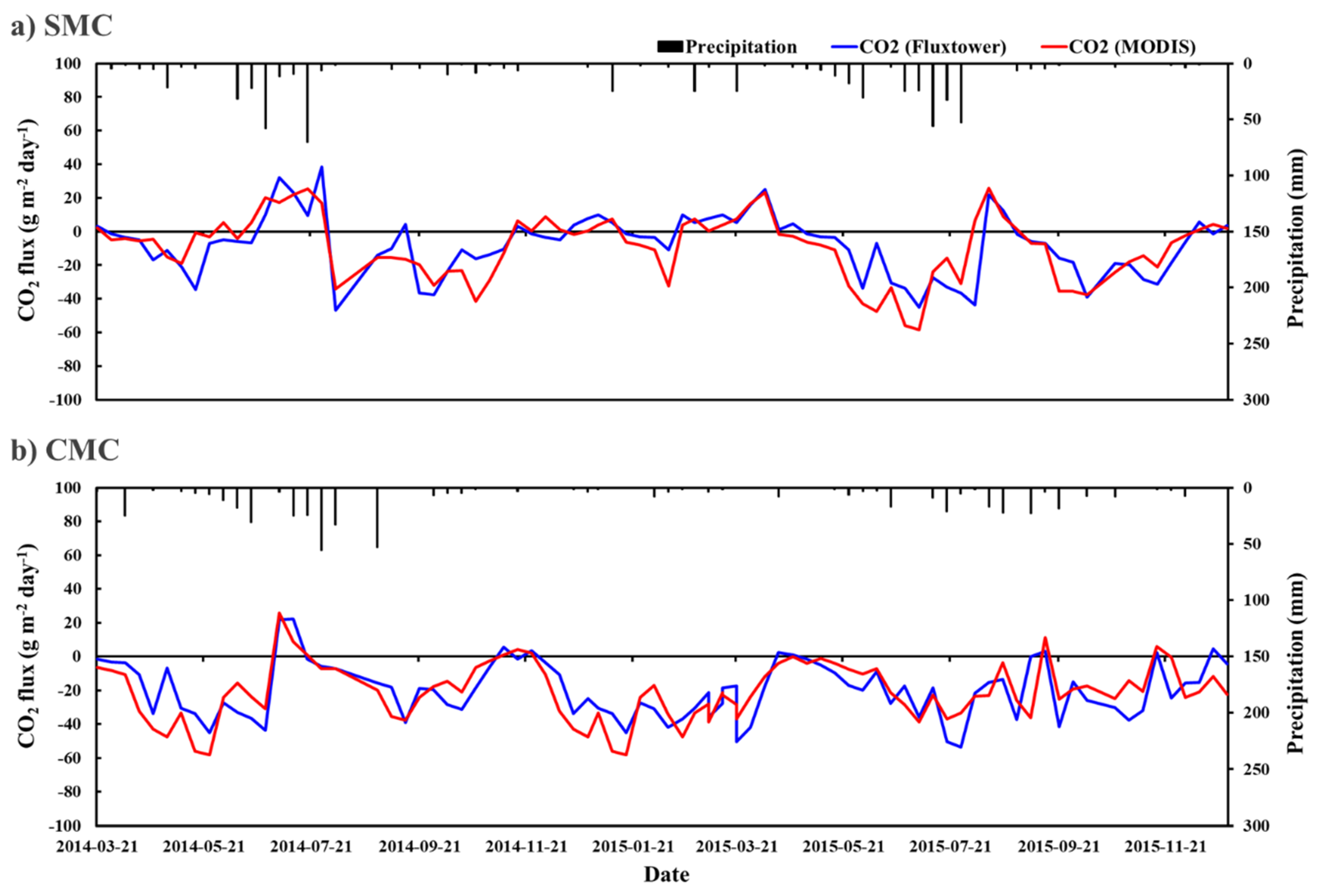

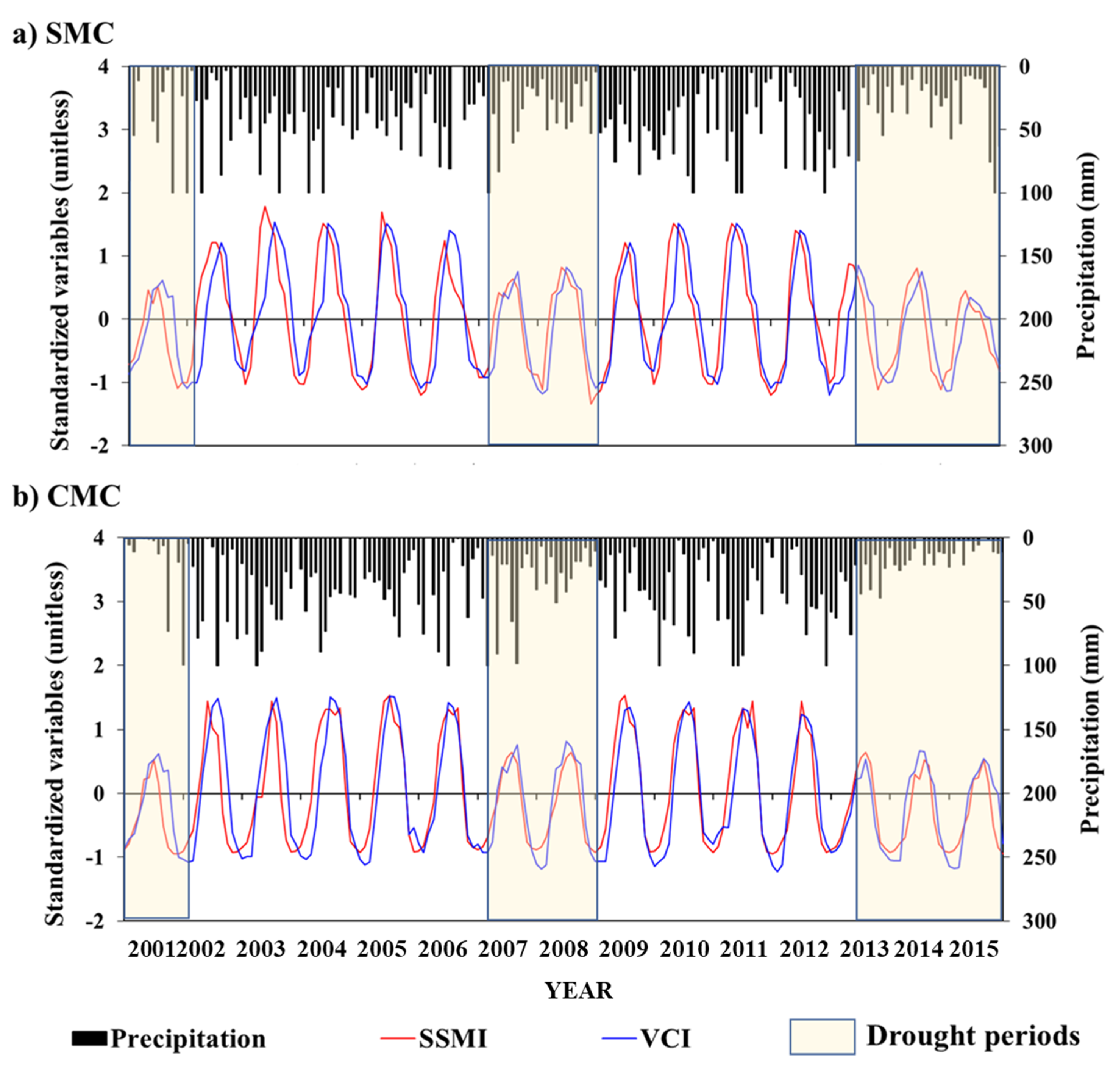
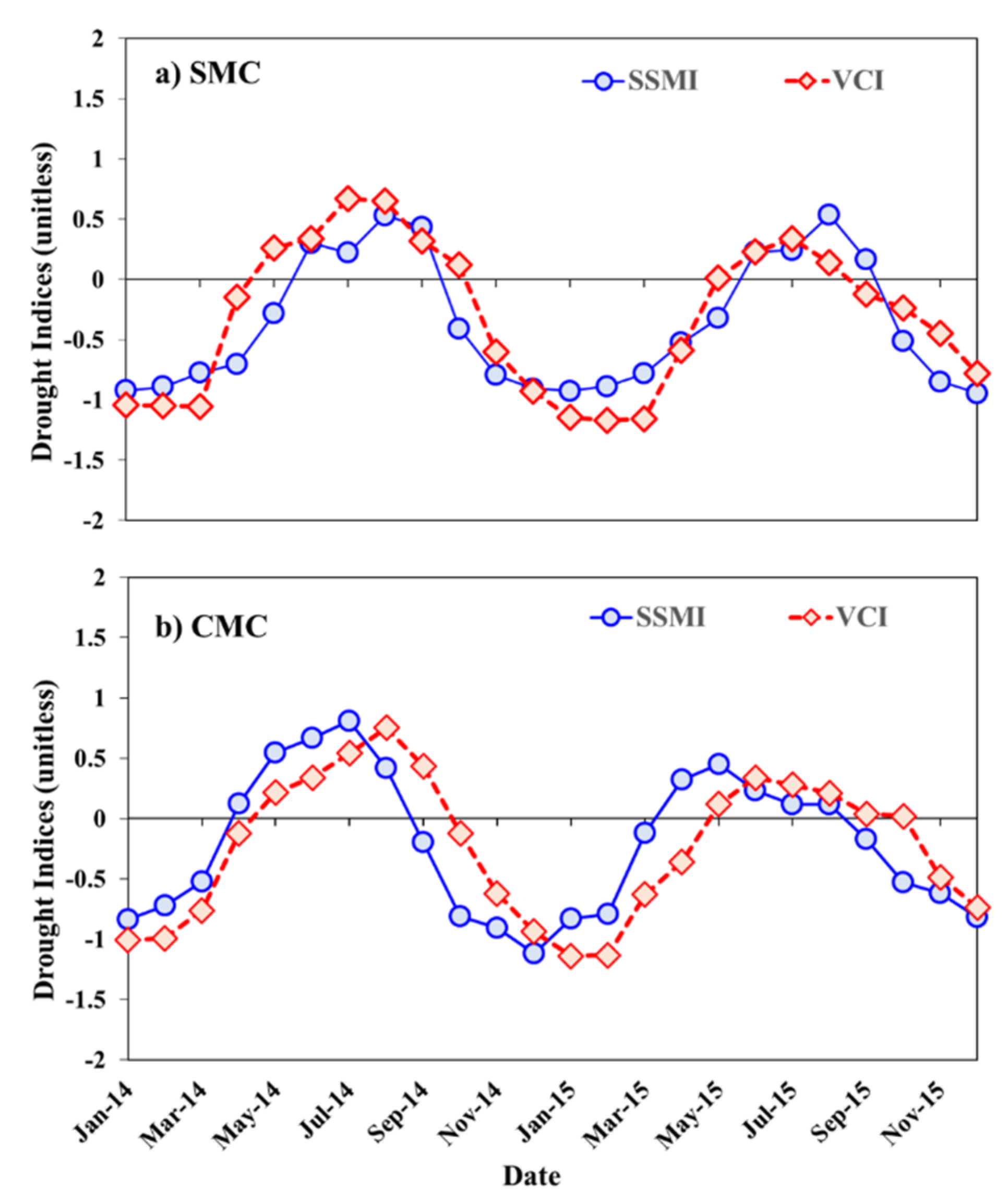
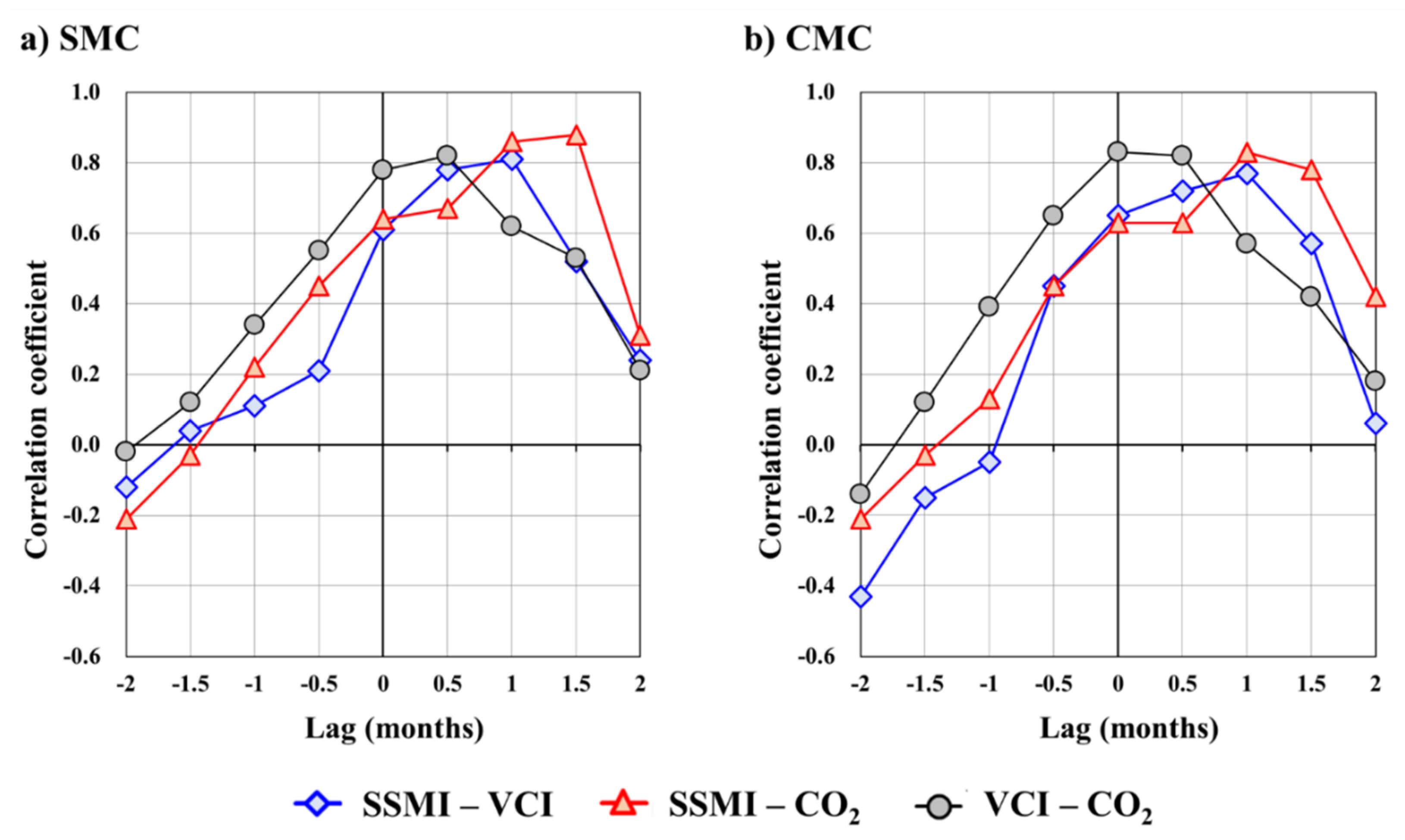
| Site | Latitude (°N) | Longitude (°E) | Altitude (m) | Land Cover | LAI | Terrain |
|---|---|---|---|---|---|---|
| Cheonmicheon (CMC) | 37.16 | 127.65 | 141 | Rice Paddy | 1–2 | Flat |
| Sulmacheon (SMC) | 37.94 | 126.95 | 293 | Mixed Forest | 6–8 | Mountainous |
| Product ID | Product | Spatial Resolution (km) | Temporal Resolution |
|---|---|---|---|
| MOD11A1 | Land surface temperature | 0.5 | Daily |
| MCD12Q1 | Land cover | 0.5 | Yearly |
| MOD13A1 | Vegetation indices | 0.5 | 16 days |
| MOD17A2H | Gross primary productivity | 0.5 | 8 days |
| MCD43A3 | Albedo | 0.5 | Daily |
| Site | Bias (m3 m−3) | RMSE (m3 m−3) | a 1 | Coefficients of Correlation |
|---|---|---|---|---|
| SMC | −3.87 | 8.25 | 0.81 | 0.75 * |
| CMC | −0.20 | 7.86 | 0.58 | 0.66 * |
| Site | Bias (g m−2 d−1) | RMSE (g m−2 d−1) | a 1 | Coefficients of Correlation |
|---|---|---|---|---|
| SMC | 0.93 | 12.46 | 0.79 | 0.76 * |
| CMC | −1.37 | 12.52 | 0.74 | 0.72 * |
| (a) SMC | Soil Moisture | Sum | Drought Accuracy | ||
| Drought | No Drought | ||||
| Moderate drought ((SMfluxtower_median) = 23.14 m3 m−3) | |||||
| SSMI | Drought | 8 | 3 | 11 | 8 / 11 = 72.73% |
| No drought | 3 | 10 | 13 | ||
| Sum | 11 | 13 | 24 | ||
| VCI | Drought | 7 | 4 | 11 | 7 / 11 = 63.64% |
| No drought | 5 | 8 | 13 | ||
| Sum | 12 | 12 | 24 | ||
| Severe drought ((SMfluxtower_lower quartile) = 8.34 m3 m−3) | |||||
| SSMI | Drought | 6 | 6 | 12 | 6 / 12 = 50.00% |
| No drought | 4 | 8 | 12 | ||
| Sum | 10 | 14 | 24 | ||
| VCI | Drought | 7 | 5 | 12 | 7 / 12 = 58.33% |
| No drought | 3 | 9 | 12 | ||
| Sum | 10 | 14 | 24 | ||
| (b) CMC | Soil Moisture | Sum | Drought Accuracy | ||
| Drought | No Drought | ||||
| Moderate drought ((SMfluxtower_median) = 25.37 m3 m−3) | |||||
| SSMI | Drought | 7 | 2 | 9 | 7 / 9 = 77.78% |
| No drought | 3 | 12 | 15 | ||
| Sum | 10 | 14 | 24 | ||
| VCI | Drought | 6 | 3 | 9 | 6 / 9 = 66.67% |
| No drought | 6 | 9 | 15 | ||
| Sum | 12 | 12 | 24 | ||
| Severe drought ((SMfluxtower_lower quartile) = 9.28 m3 m−3) | |||||
| SSMI | Drought | 5 | 3 | 8 | 5 / 8 = 62.50% |
| No drought | 8 | 8 | 16 | ||
| Sum | 13 | 11 | 24 | ||
| VCI | Drought | 6 | 4 | 10 | 6 / 10 = 60.00% |
| No drought | 8 | 6 | 14 | ||
| Sum | 14 | 10 | 24 | ||
| (a) SMC | Lag Time (Month) | ||||||||
| −2.0 | −1.5 | −1.0 | −0.5 | 0 | 0.5 | 1.0 | 1.5 | 2.0 | |
| SM – NDVI | −0.12 | 0.04 | 0.11 | 0.21 | 0.61 | 0.78 * | 0.81 * | 0.52 | 0.24 |
| SM – CO2 | −0.21 | −0.03 | 0.22 | 0.45 | 0.64 | 0.67 | 0.86 * | 0.88 * | 0.31 |
| NDVI – CO2 | −0.02 | 0.12 | 0.34 | 0.55 | 0.78 * | 0.82 * | 0.62 | 0.53 | 0.21 |
| (b) CMC | Lag Time (Month) | ||||||||
| −2.0 | −1.5 | −1.0 | −0.5 | 0 | 0.5 | 1.0 | 1.5 | 2.0 | |
| SM – NDVI | −0.43 | −0.15 | −0.05 | 0.45 | 0.65 | 0.72 * | 0.77 * | 0.57 | 0.06 |
| SM – CO2 | −0.21 | −0.03 | 0.13 | 0.45 | 0.63 | 0.63 | 0.83 * | 0.78 * | 0.42 |
| NDVI – CO2 | −0.14 | 0.12 | 0.39 | 0.65 | 0.83 * | 0.82 * | 0.57 | 0.42 | 0.18 |
© 2020 by the authors. Licensee MDPI, Basel, Switzerland. This article is an open access article distributed under the terms and conditions of the Creative Commons Attribution (CC BY) license (http://creativecommons.org/licenses/by/4.0/).
Share and Cite
Sur, C.; Kang, D.-H.; Lim, K.J.; Yang, J.E.; Shin, Y.; Jung, Y. Soil Moisture–Vegetation–Carbon Flux Relationship under Agricultural Drought Condition using Optical Multispectral Sensor. Remote Sens. 2020, 12, 1359. https://doi.org/10.3390/rs12091359
Sur C, Kang D-H, Lim KJ, Yang JE, Shin Y, Jung Y. Soil Moisture–Vegetation–Carbon Flux Relationship under Agricultural Drought Condition using Optical Multispectral Sensor. Remote Sensing. 2020; 12(9):1359. https://doi.org/10.3390/rs12091359
Chicago/Turabian StyleSur, Chanyang, Do-Hyuk Kang, Kyoung Jae Lim, Jae E. Yang, Yongchul Shin, and Younghun Jung. 2020. "Soil Moisture–Vegetation–Carbon Flux Relationship under Agricultural Drought Condition using Optical Multispectral Sensor" Remote Sensing 12, no. 9: 1359. https://doi.org/10.3390/rs12091359
APA StyleSur, C., Kang, D.-H., Lim, K. J., Yang, J. E., Shin, Y., & Jung, Y. (2020). Soil Moisture–Vegetation–Carbon Flux Relationship under Agricultural Drought Condition using Optical Multispectral Sensor. Remote Sensing, 12(9), 1359. https://doi.org/10.3390/rs12091359







